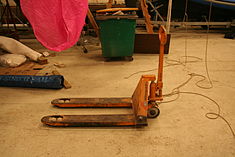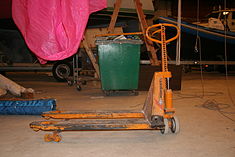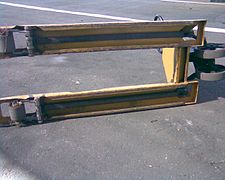
A tractor is an engineering vehicle specifically designed to deliver a high tractive effort at slow speeds, for the purposes of hauling a trailer or machinery such as that used in agriculture, mining or construction. Most commonly, the term is used to describe a farm vehicle that provides the power and traction to mechanize agricultural tasks, especially tillage, and now many more. Agricultural implements may be towed behind or mounted on the tractor, and the tractor may also provide a source of power if the implement is mechanised.

A skid loader, skid-steer loader, SSL, or skidsteer is any of a class of compact heavy equipment with lift arms that can attach to a wide variety of buckets and other labor-saving tools or attachments.

A forklift is a powered industrial truck used to lift and move materials over short distances. The forklift was developed in the early 20th century by various companies, including Clark, which made transmissions, and Yale & Towne Manufacturing, which made hoists. Since World War II, the use and development of the forklift truck have greatly expanded worldwide. Forklifts have become an indispensable piece of equipment in manufacturing and warehousing. In 2013, the top 20 manufacturers worldwide posted sales of $30.4 billion, with 944,405 machines sold.

Steering is the control of the direction of locomotion or the components that enable its control. Steering is achieved through various arrangements, among them ailerons for airplanes, rudders for boats, tilting rotors for helicopters, and many more.

A crane is a machine used move materials both vertically and horizontally, utilizing a system of a boom, hoist, wire ropes or chains, and sheaves used for lifting and relocating heavy objects, typically within the swing of its boom. The device uses one or more simple machines - such as the lever and pulley - to create mechanical advantage to do its work. Cranes are commonly employed in transportation for the loading and unloading of freight, in construction for the movement of materials, and in manufacturing for the assembling of heavy equipment.
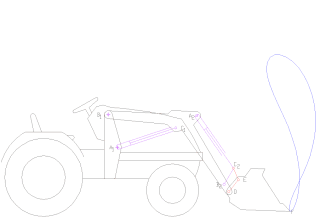
A loader is a heavy equipment machine used in construction to move or load materials such as soil, rock, sand, demolition debris, etc. into or onto another type of machinery.

A lift table is a device that employs a scissors mechanism to raise or lower goods and/or persons. Typically lift tables are used to raise large, heavy loads through relatively small distances. Common applications include pallet handling, vehicle loading and work positioning. Lift tables are a recommended way to help reduce incidents of musculoskeletal disorders by correctly re-positioning work at a suitable height for operators. Lift tables lend themselves to being easily adapted to a specific use. They can work in hostile environments, be manufactured in stainless steel and have equipment like conveyors, turn-tables, barriers and gates easily added to their deckplates.
Power steering is a system for reducing a driver's effort to turn a steering wheel of a motor vehicle, by using a power source to assist steering.

A telescopic handler, also called a lull, telehandler, teleporter, reach forklift, or zoom boom, is a machine widely used in agriculture and industry. It is somewhat like a forklift but has a boom, making it more a crane than a forklift, with the increased versatility of a single telescopic boom that can extend forwards and upwards from the vehicle. The boom can be fitted with different attachments, such as a bucket, pallet forks, muck grab, or winch.

A loading dock or loading bay is an area of a building where goods vehicles are loaded and unloaded. They are commonly found on commercial and industrial buildings, and warehouses in particular. Loading docks may be exterior, flush with the building envelope, or fully enclosed. They are part of a facility's service or utility infrastructure, typically providing direct access to staging areas, storage rooms, and freight elevators.
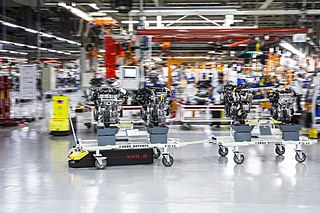
An automated guided vehicle (AGV), different from an autonomous mobile robot (AMR), is a portable robot that follows along marked long lines or wires on the floor, or uses radio waves, vision cameras, magnets, or lasers for navigation. They are most often used in industrial applications to transport heavy materials around a large industrial building, such as a factory or warehouse. Application of the automatic guided vehicle broadened during the late 20th century.

The UK All Terrain Mobility Platform is commonly known by the name of its manufacturer Supacat. It is a lightweight, 6-wheeled vehicle used by airborne and air-mobile forces of the British Army since 1988.

A jack is a mechanical lifting device used to apply great forces or lift heavy loads. A mechanical jack employs a screw thread for lifting heavy equipment. A hydraulic jack uses hydraulic power. The most common form is a car jack, floor jack or garage jack, which lifts vehicles so that maintenance can be performed. Jacks are usually rated for a maximum lifting capacity. Industrial jacks can be rated for many tons of load.

A semi-trailer is a trailer without a front axle. The combination of a semi-trailer and a tractor truck is called a semi-trailer truck.

Ground support equipment (GSE) is the support equipment found at an airport, usually on the apron, the servicing area by the terminal. This equipment is used to service the aircraft between flights. As the name suggests, ground support equipment is there to support the operations of aircraft whilst on the ground. The role of this equipment generally involves ground power operations, aircraft mobility, and cargo/passenger loading operations.

The Meillerwagen was a German World War II trailer used to transport a V-2 rocket from the 'transloading point' of the Technical Troop Area to the launching point, to erect the missile on the Brennstand, and to act as the service gantry for fuelling and launch preparation.

Material handling equipment (MHE) is mechanical equipment used for the movement, storage, control, and protection of materials, goods and products throughout the process of manufacturing, distribution, consumption, and disposal. The different types of equipment can be classified into four major categories: transport equipment, positioning equipment, unit load formation equipment, and storage equipment.
A Drum handler is a piece of mechanical equipment that is used to securely grip, lift and transport cylindrical modules such as steel drums, barrels, plastic drums and fiber drums. It has spring-loaded metal arms to create a tight and secure grip. This equipment is commonly used in chemical and petroleum industries, as well as industries that require shipping and storing of cylindrical modules.
An electric tug is a battery-powered and pedestrian-operated machine used to move heavy loads on wheels.

Car controls are the components in automobiles and other powered road vehicles, such as trucks and buses, used for driving and parking.

